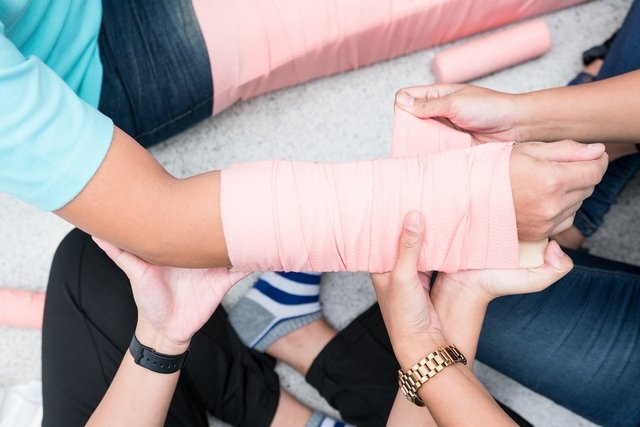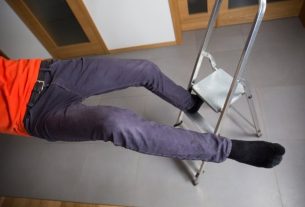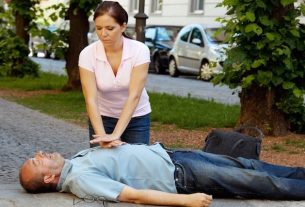In case of a suspected fracture, which is when the bone breaks or cracks, it is very important to remain calm, calm the victim and observe if there are any injuries or bleeding, and call the SAMU 192 mobile emergency service.
In cases of fractures in the hand, arm or leg, the fracture can be immobilized so that the affected limb is aligned and if it is an open fracture, before immobilizing, the wound must be washed with saline solution.
When fractures occur due to accidents or trauma, and there is a suspicion of multiple fractures, or a fracture in the spine, neck or skull, the ideal is to check if the victim is breathing, and not move him or her, until SAMU arrives at the scene. Find out what first aid should be like for head trauma.

First aid for fractures
To provide first aid for fractures in arms, legs or hands, you must:
- Keep the affected limb at restin a natural and comfortable position;
- Do not put pressure on the fracture site and check the color of the affected limb to check if it has adequate blood circulation;
- Immobilize the joints above and below the injury, with the use of splints. If there are no splints available, it is possible to improvise with pieces of cardboard, folded magazines or newspapers or pieces of wood, which must be padded with clean cloths and tied around the joint;
- Wash the area with 0.9% saline solutionbefore immobilizing, in the case of an open fracture;
- Cover the wound, in the case of an open fracture, preferably with sterilized gauze or a clean cloth. If there is very intense bleeding, it is necessary to apply compression above the fractured region to try to prevent the blood from escaping. Find out more details about first aid in case of an open fracture;
- Never try to straighten a fracture or put the bone in place;
- Do not move the victim, until the limb is safe and help arrives, unless the person has cardiorespiratory arrest. In these cases, the victim should move as little as possible and as a whole, and begin cardiac massage. Learn how to do cardiac massage correctly;
- Wait for medical help. If this is not possible, it is recommended to take the victim to the nearest emergency room.
A fracture occurs when the bone breaks or cracks due to an impact greater than the bone can withstand.
Furthermore, with aging and certain bone diseases, such as osteoporosis, the risk of fractures increases, which can occur even with minor movements or impacts. Find out the best treatments and exercises to strengthen bones and avoid fractures.
How to immobilize the affected limb
Immobilizing the fractured limb is very important to try to avoid worsening the fracture and ensure that the tissues continue to be correctly perfused with blood. Therefore, to carry out immobilization you must:
1. In closed fracture
A closed fracture is one in which the bone has broken, but the skin is closed, intact and without open wounds, preventing the bone from being seen.
In these cases, a splint must be placed on each side of the fracture and a bandage must be applied from the beginning to the end of the splints. Ideally, splints should go above and below the joints near the site.
2. In open fracture
In an open fracture, the bone is exposed and, therefore, the area should not be covered with a bandage when immobilizing, as this not only worsens the pain, but also encourages the entry of microorganisms into the wound and infections.
In these cases, a splint must be placed behind the affected area and then, with a bandage, tied above and below the fracture, leaving it exposed.
When to suspect a fracture
A fracture should be suspected whenever an impact occurs on a limb, accompanied by symptoms such as:
- Intense pain;
- Swelling or deformation;
- Formation of a purplish area;
- Noises when moving the affected limb or inability to move it;
- Shortening of the affected limb.
If the fracture is exposed, it is possible to see the bone sticking out of the skin, and intense bleeding is common. Know how to identify the main symptoms of fracture.
The fracture is confirmed by the doctor after physical assessment and an x-ray of the affected person, and then the orthopedist will be able to indicate the most recommended treatment, which involves repositioning the bone, immobilization with splints and plasters or, in some cases, surgery.
Bibliography
- MINISTRY OF HEALTH. First Aid: Do you know what to do in case of a fracture?. Available at: <https://bvsms.saude.gov.br/bvs/folder/10006003165.pdf>. Accessed on Aug 31, 2023
- GOIÁS FIRE DEPARTMENT. First aid. Available at: <https://www.bombeiros.go.gov.br/wp-content/uploads/2012/06/cartilha- Primeiros-socorros.pdf>. Accessed on Aug 31, 2023
- SYNDER, CJ; LOTHAMER, C. Patient Triage, First Aid Care, and Management of Oral and Maxillofacial Trauma. Vet Clin North Am Small Anim Pract. 52. 1; 271-288, 2022
- ST JOHN AMBULANCE. Fractures (broken bones). 2023. Disponível em: <https://www.sja.org.uk/get-advice/first-aid-advice/bones-and-muscle-injuries/broken-bones-and-fractures/>. Acesso em 31 ago 2023
- BAPTISTA, N. T. First Aid Manual. 3ed. Sintra, Portugal: Escola Nacional de Bombeiros, 2012. 151-157.

Sign up for our newsletter and stay up to date with exclusive news
that can transform your routine!
Warning: Undefined array key "title" in /home/storelat/public_html/wp-content/plugins/link-whisper-premium/templates/frontend/related-posts.php on line 12
Warning: Undefined array key "title_tag" in /home/storelat/public_html/wp-content/plugins/link-whisper-premium/templates/frontend/related-posts.php on line 13



